外研版(2019)选择性必修 第四册 Unit 4 Everyday economics Developing ideas Reading课件(共26张)
文档属性
| 名称 | 外研版(2019)选择性必修 第四册 Unit 4 Everyday economics Developing ideas Reading课件(共26张) |  | |
| 格式 | pptx | ||
| 文件大小 | 9.2MB | ||
| 资源类型 | 教案 | ||
| 版本资源 | 外研版(2019) | ||
| 科目 | 英语 | ||
| 更新时间 | 2025-05-02 18:26:04 | ||
图片预览

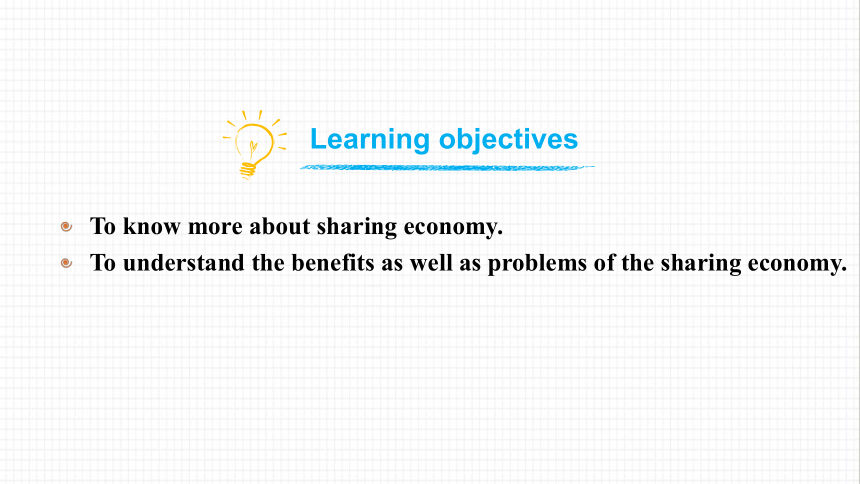
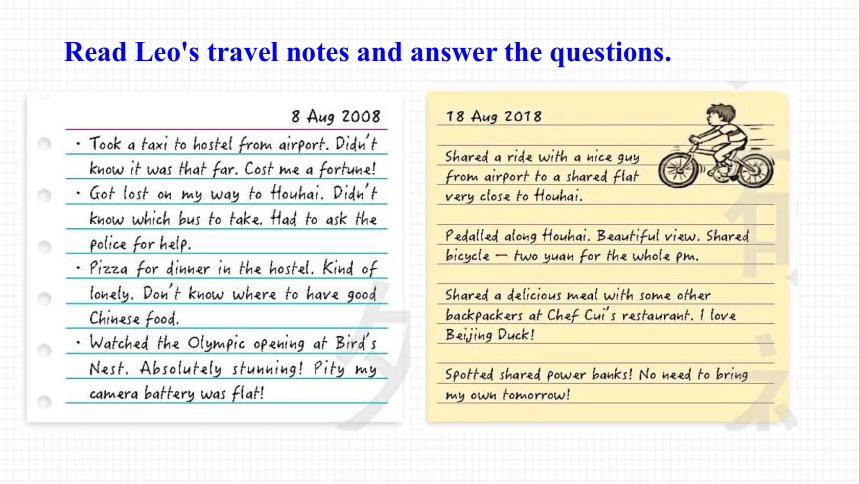
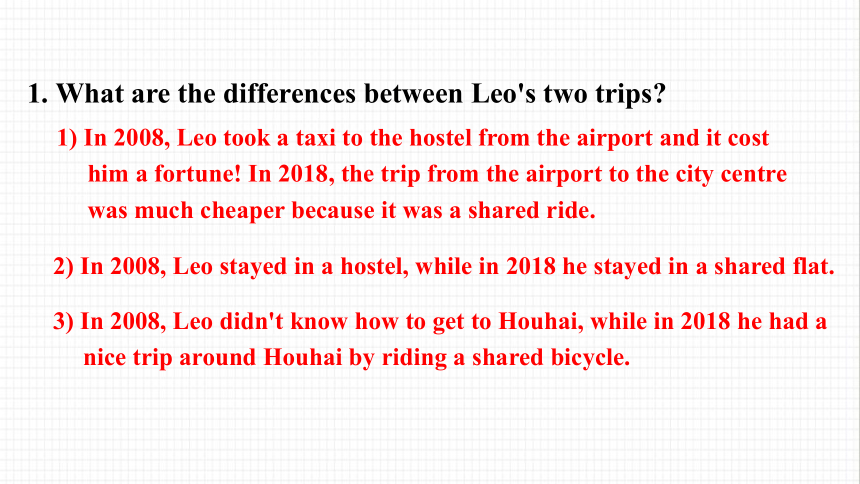
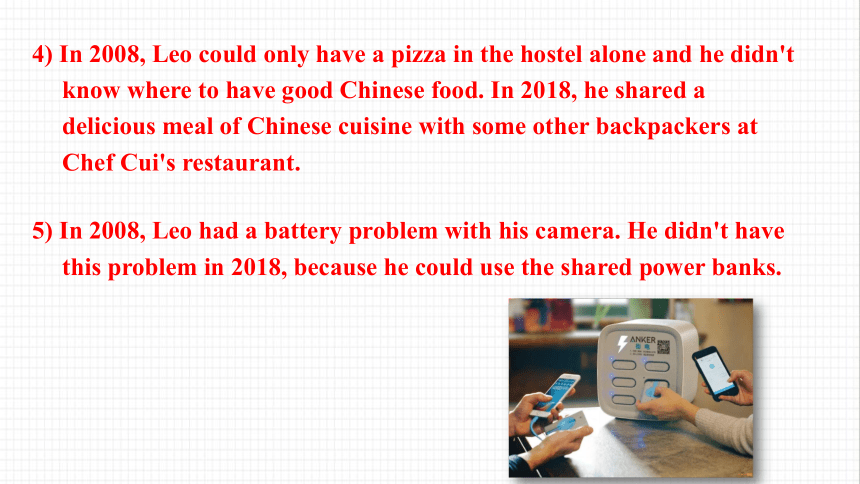
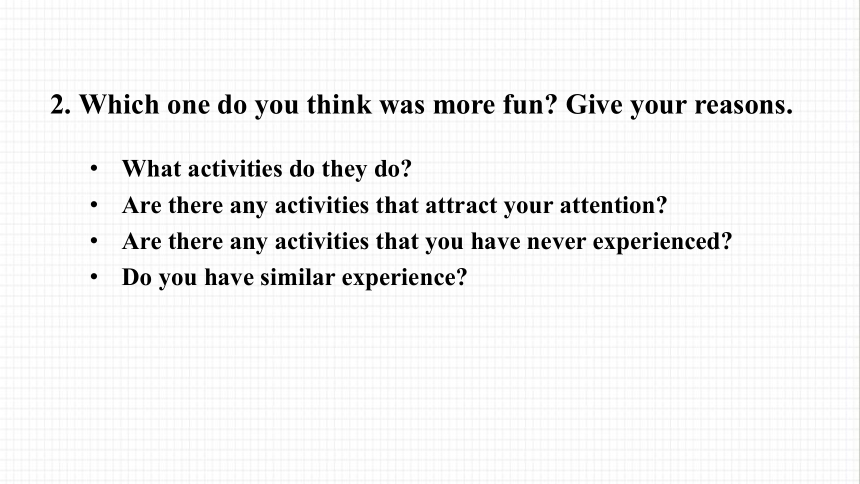
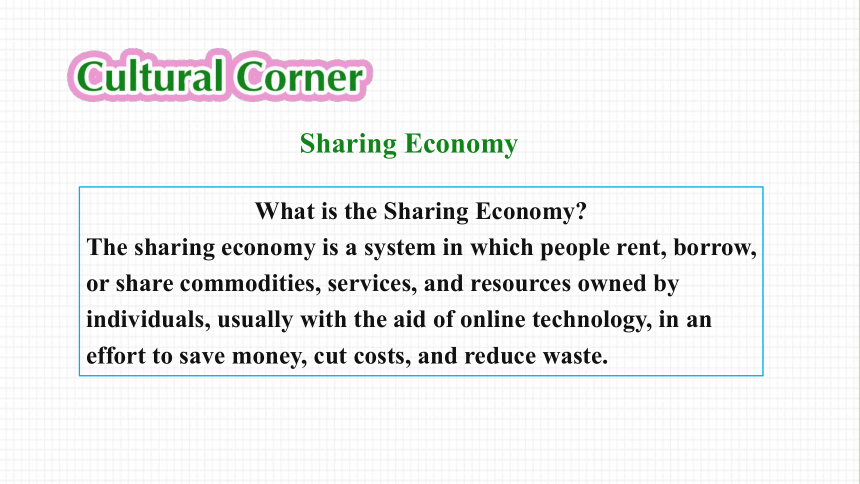

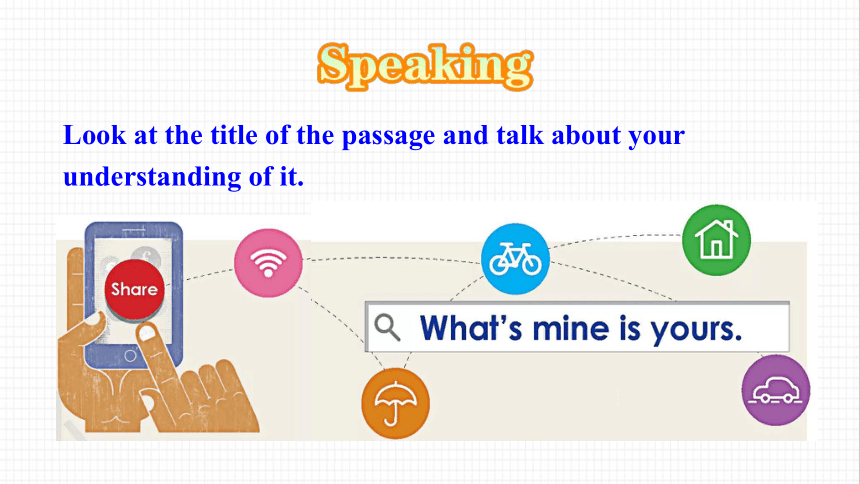
文档简介
(共26张PPT)
Unit 4 Everyday economics
Developing ideas
What’s mine is yours.
To know more about sharing economy.
To understand the benefits as well as problems of the sharing economy.
Learning objectives
Read Leo's travel notes and answer the questions.
1. What are the differences between Leo's two trips
1) In 2008, Leo took a taxi to the hostel from the airport and it cost him a fortune! In 2018, the trip from the airport to the city centre was much cheaper because it was a shared ride.
2) In 2008, Leo stayed in a hostel, while in 2018 he stayed in a shared flat.
3) In 2008, Leo didn't know how to get to Houhai, while in 2018 he had a nice trip around Houhai by riding a shared bicycle.
4) In 2008, Leo could only have a pizza in the hostel alone and he didn't know where to have good Chinese food. In 2018, he shared a delicious meal of Chinese cuisine with some other backpackers at Chef Cui's restaurant.
5) In 2008, Leo had a battery problem with his camera. He didn't have this problem in 2018, because he could use the shared power banks.
2. Which one do you think was more fun Give your reasons.
What activities do they do
Are there any activities that attract your attention
Are there any activities that you have never experienced
Do you have similar experience
Sharing Economy
What is the Sharing Economy
The sharing economy is a system in which people rent, borrow, or share commodities, services, and resources owned by individuals, usually with the aid of online technology, in an effort to save money, cut costs, and reduce waste.
China’s Sharing Economy
China is fast embracing (拥抱; 接受,采纳) the sharing economy, having come up with its own innovative (创新的) resource sharing platforms.
According to a report published by China’s State Information Center, the sharing economy is expected to maintain a 40 percent annual growth rate, and is officially forecast to account for over 20 percent of the country’s GDP by the year 2025.
Look at the title of the passage and talk about your understanding of it.
Match the paragraphs to their functions and give your reasons.
a To highlight the key benefits of the sharing economy.
b To explain and elaborate on the sharing economy.
c To lead the topic from sharing in children to sharing in economic activities.
d To illustrate various drawbacks of the sharing economy.
e To predict the future of the sharing economy.
3
2
1
4
5
Introduce the topic of sharing
benefits of sharing
problems of sharing
Explain the sharing economy
Predict the future of sharing economy
Think about the structure of the passage and complete the diagram.
Benefits
It meets people's increasing demand for _____________________________________________.
It allows people to make or save money.
It helps people ____________________ and even ________________.
It favours the environment by ________________________ ________ and ___________________.
quality goods and services at competitive prices
make connections
make new friends
encouraging people to reuse
reducing pollution
items
Problems
The sharing economy is developing faster than _________________________________________.
The sharing economy is subject to ____________________.
Personal information about __________________________ is ______________ in the sharing economy.
existing regulations or ongoing supervision
abuse of trust
almost every part of our lives
not yet secure
Choose the best answers.
1. What’s the writer’s attitude to the sharing economy
A. Doubtful. B. Positive. C. Negative D. Indifferent.
2. Which is wrong about the sharing economy according to the passage
A. It benefits the two sides of dealing.
B. It encourages people to reuse things.
C. It can do good to environment.
D. It is developing so fast that it doesn’t need supervising.
3. How many benefits of the sharing economy are mentioned in the passage
A. 3. B. 4. C. 5 D. 6.
4. Which is not included in personal information
A. Our names.
B. Our addresses.
C. Our shopping preference.
D. Our friends.
A two-sided argumentative essay investigates a topic by presenting collated information and evaluating evidence from both sides. It should close by wrapping up the argument. It could conclude in favour of the arguments, or simply stay neutral with no particular preference.
正反论证议论文:Two-sided argumentative essays以议论为主要表达方式,通过正反双面论证、分析利弊,全方位、多角度分析某一现象或事件。有些作者会在文章结尾表明自己的观点态度和主张,一些则保持中立,不表明立场。
What’s mine is yours.属于正反论证议论文。以share为话题。第一、二段从儿时的分享经历引出时代赋予“共享”的新内涵。第三段重点阐述共享带给人们的好处:通过简单便捷的方式提供质优价廉的商品与服务、为共享双方提供双赢的机会、发展人际关系、提高物品的循环利用率、减少浪费等。
正反论证议论文的结构特征
第四段从反面揭示共享的弊端:新兴行业发展过快超越了现有法律法规的约束与监管、部分企业以不正当手段抢占市场份额、泄露个人信息,造成经济损失,甚至威胁人身安全。
第五段总结,共享经济将与人们生活产生更加紧密的联系,同时留给读者一系列问题进行思考,并未表明自己的观点和态度。
建议在阅读正反论证议论文时先找话题,然后分别找到正反两面提出的论点及论据,最后找到文章的结论。只有这样,才能完全理清一篇正反论证议论文的结构。
1. What is the author's attitude towards the sharing economy
The author acknowledges the benefits of the sharing economy, but he also takes concern about the problems of it. The author is also curious about the future of the sharing economy.
2. What do you think are other benefits and problems of the sharing economy How could we address the potential problems
Read the report and find some clues.
3. What are your experiences of the sharing economy Share these experiences with the class.
4. How do the two reading passages in this unit help deepen your understanding of new economic trends
With the development of society, people can find more opportunities to realize their dreams. You can start your own business or you can use what is around you to make your life much easier.
Talk about the future of the sharing economy.
1. Think about what will happen in the next 20 years as the world's economy becomes ever more global and digital. Consider the following:
What will people be sharing next
How will they be sharing these things
What benefits will people get from sharing these things
What are the potential problems
2. Share your ideas with your group.
3. Present your group’s ideas to the class.
Now think about how the other groups’ ideas were different to your own and whether you agree with them.
1. Write a short passage about the other benefits and problems of the sharing economy in 80 words.
2. Preview Writing.
Homework
Unit 4 Everyday economics
Developing ideas
What’s mine is yours.
To know more about sharing economy.
To understand the benefits as well as problems of the sharing economy.
Learning objectives
Read Leo's travel notes and answer the questions.
1. What are the differences between Leo's two trips
1) In 2008, Leo took a taxi to the hostel from the airport and it cost him a fortune! In 2018, the trip from the airport to the city centre was much cheaper because it was a shared ride.
2) In 2008, Leo stayed in a hostel, while in 2018 he stayed in a shared flat.
3) In 2008, Leo didn't know how to get to Houhai, while in 2018 he had a nice trip around Houhai by riding a shared bicycle.
4) In 2008, Leo could only have a pizza in the hostel alone and he didn't know where to have good Chinese food. In 2018, he shared a delicious meal of Chinese cuisine with some other backpackers at Chef Cui's restaurant.
5) In 2008, Leo had a battery problem with his camera. He didn't have this problem in 2018, because he could use the shared power banks.
2. Which one do you think was more fun Give your reasons.
What activities do they do
Are there any activities that attract your attention
Are there any activities that you have never experienced
Do you have similar experience
Sharing Economy
What is the Sharing Economy
The sharing economy is a system in which people rent, borrow, or share commodities, services, and resources owned by individuals, usually with the aid of online technology, in an effort to save money, cut costs, and reduce waste.
China’s Sharing Economy
China is fast embracing (拥抱; 接受,采纳) the sharing economy, having come up with its own innovative (创新的) resource sharing platforms.
According to a report published by China’s State Information Center, the sharing economy is expected to maintain a 40 percent annual growth rate, and is officially forecast to account for over 20 percent of the country’s GDP by the year 2025.
Look at the title of the passage and talk about your understanding of it.
Match the paragraphs to their functions and give your reasons.
a To highlight the key benefits of the sharing economy.
b To explain and elaborate on the sharing economy.
c To lead the topic from sharing in children to sharing in economic activities.
d To illustrate various drawbacks of the sharing economy.
e To predict the future of the sharing economy.
3
2
1
4
5
Introduce the topic of sharing
benefits of sharing
problems of sharing
Explain the sharing economy
Predict the future of sharing economy
Think about the structure of the passage and complete the diagram.
Benefits
It meets people's increasing demand for _____________________________________________.
It allows people to make or save money.
It helps people ____________________ and even ________________.
It favours the environment by ________________________ ________ and ___________________.
quality goods and services at competitive prices
make connections
make new friends
encouraging people to reuse
reducing pollution
items
Problems
The sharing economy is developing faster than _________________________________________.
The sharing economy is subject to ____________________.
Personal information about __________________________ is ______________ in the sharing economy.
existing regulations or ongoing supervision
abuse of trust
almost every part of our lives
not yet secure
Choose the best answers.
1. What’s the writer’s attitude to the sharing economy
A. Doubtful. B. Positive. C. Negative D. Indifferent.
2. Which is wrong about the sharing economy according to the passage
A. It benefits the two sides of dealing.
B. It encourages people to reuse things.
C. It can do good to environment.
D. It is developing so fast that it doesn’t need supervising.
3. How many benefits of the sharing economy are mentioned in the passage
A. 3. B. 4. C. 5 D. 6.
4. Which is not included in personal information
A. Our names.
B. Our addresses.
C. Our shopping preference.
D. Our friends.
A two-sided argumentative essay investigates a topic by presenting collated information and evaluating evidence from both sides. It should close by wrapping up the argument. It could conclude in favour of the arguments, or simply stay neutral with no particular preference.
正反论证议论文:Two-sided argumentative essays以议论为主要表达方式,通过正反双面论证、分析利弊,全方位、多角度分析某一现象或事件。有些作者会在文章结尾表明自己的观点态度和主张,一些则保持中立,不表明立场。
What’s mine is yours.属于正反论证议论文。以share为话题。第一、二段从儿时的分享经历引出时代赋予“共享”的新内涵。第三段重点阐述共享带给人们的好处:通过简单便捷的方式提供质优价廉的商品与服务、为共享双方提供双赢的机会、发展人际关系、提高物品的循环利用率、减少浪费等。
正反论证议论文的结构特征
第四段从反面揭示共享的弊端:新兴行业发展过快超越了现有法律法规的约束与监管、部分企业以不正当手段抢占市场份额、泄露个人信息,造成经济损失,甚至威胁人身安全。
第五段总结,共享经济将与人们生活产生更加紧密的联系,同时留给读者一系列问题进行思考,并未表明自己的观点和态度。
建议在阅读正反论证议论文时先找话题,然后分别找到正反两面提出的论点及论据,最后找到文章的结论。只有这样,才能完全理清一篇正反论证议论文的结构。
1. What is the author's attitude towards the sharing economy
The author acknowledges the benefits of the sharing economy, but he also takes concern about the problems of it. The author is also curious about the future of the sharing economy.
2. What do you think are other benefits and problems of the sharing economy How could we address the potential problems
Read the report and find some clues.
3. What are your experiences of the sharing economy Share these experiences with the class.
4. How do the two reading passages in this unit help deepen your understanding of new economic trends
With the development of society, people can find more opportunities to realize their dreams. You can start your own business or you can use what is around you to make your life much easier.
Talk about the future of the sharing economy.
1. Think about what will happen in the next 20 years as the world's economy becomes ever more global and digital. Consider the following:
What will people be sharing next
How will they be sharing these things
What benefits will people get from sharing these things
What are the potential problems
2. Share your ideas with your group.
3. Present your group’s ideas to the class.
Now think about how the other groups’ ideas were different to your own and whether you agree with them.
1. Write a short passage about the other benefits and problems of the sharing economy in 80 words.
2. Preview Writing.
Homework
